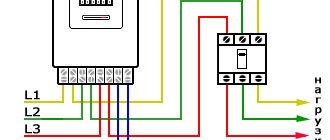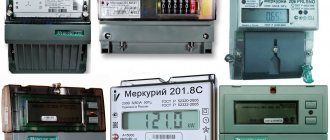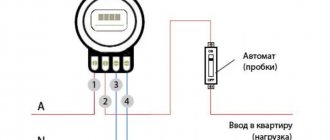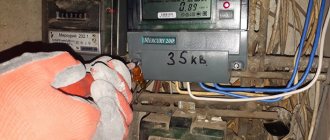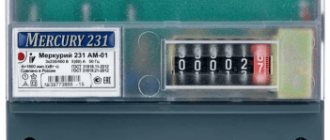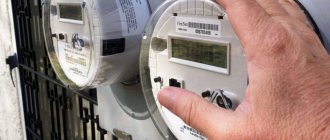Classification of electric energy meters
The classification of electrical energy metering devices is based on several principles by which they are divided.
Based on the operating principle:
- induction (electromechanical);
- electrodynamic;
- electronic;
- hybrid.
By accuracy class:
- workers;
- reference.
By the number of tariffs applied:
- single-tariff - energy meters without taking into account time intervals;
- two-tariff - used to take into account energy readings in two time periods (for example, during the day and night), while consumption is recorded independently in separate lines;
- multi-tariff - the electric meter works on the same principle as the previous one, but there can be at least three time intervals.
According to the principle of inclusion in electrical networks:
- direct connection - connected to the network without instrument transformers. Such meters are suitable for 0.4/0.23 kV networks at currents up to 100 A;
- transformer connection - needed for connection with established transformation ratios.
By type of network connection:
- single-phase - installed in two-wire networks, with a standard voltage of 220 V;
- three-phase - in three or four-wire networks with a voltage of 380 V.
By type of automation:
- direct (physical) observation counter;
- meter with remote reading.
Connection diagram
The connection diagram for electricity metering devices depends on the design features of the device. Single-phase models are more often purchased by apartment owners. Therefore, it is worth considering the installation features of this type of electricity meters.
Important: before starting work, you should turn off the power to the machines or turn off the switch.
The energy metering device is connected according to the instructions. The terminal block contains 4 contacts for phase and zero input and output. That is, the former are connected to the machine, the wires from which go to the external network, and the latter to the internal network.
Attention: it is recommended to entrust the connection of the electric meter to the employees of the energy supply organization. A number of companies are ready to compensate for the costs of purchasing and installing the device if the consumer switches to another tariff plan.
In addition to the indicated electricity meters, semi-indirect and indirect switching devices are found in stores. Both devices require a transformer. Therefore, installing such meters without specialized knowledge is impossible.
Main technical characteristics
For the technical characteristics of meters, the following parameters are used:
- Accuracy class — the main technical parameter that estimates the percentage of measurement error of the device. Table of accuracy classes for rated active electricity meters
Consumption category Voltage class Metering device accuracy class Citizens (individuals) Any 2.0 and higher Entries of multi-apartment residential buildings Any 1.0 and higher Consumers with power up to 670 kW Up to 35 kW inclusive 1.0 and higher Over 110 kW 0.5S and above Consumers with power over 670 kW Any 0.5S and higher with the ability to measure hourly consumption volumes and store them for more than 90 days Electricity producers Any All old household electricity meters had an accuracy class of 2.5. Today, more accurate devices with an accuracy class of 2.0 are used.
- Multiple tariffs — the ability of modern devices to keep separate records of electricity consumption by time intervals and by seasons, which is economically beneficial to consumers and makes it possible to relieve urban energy systems during peak hours.
A two-tariff system has become widespread, allowing for separate accounting of electricity consumed at certain times of the day.
- Calibration interval - a characteristic of an electric energy meter that determines the duration of the interval between verifications, which is entered in the passport and guarantees the accuracy of the readings.
Each type and model of meter has its own calibration interval. Its duration can be from four to sixteen years.
The meter parts deteriorate over time, so the accuracy of the readings decreases. Under such circumstances, the appliance becomes unusable and the utility bill becomes invalid.
The longer the interval the manufacturer promises, the longer the electric meter will last.
When is installing such a meter beneficial?
Installing two-tariff meters will be beneficial in cases where household appliances will operate during the night. Such metering devices are suitable for those houses where:
- The heating system runs on electricity;
- there are air conditioners or heating devices;
- An electric boiler is installed.
Attention: two-tariff meters are beneficial in cases where night time accounts for up to 30-50% of total energy consumption.
In other situations, replacing a conventional electric meter with a dual-mode one can also give the desired result. However, the savings in such cases will be invisible.
Types of electricity meters
Induction meters
A familiar device with a transparent plastic window through which a rotating disk is visible. The higher the number of disk revolutions, the higher the energy consumption.
Induction electricity meters, despite their low accuracy, are considered very reliable. Their warranty period is 15 years.
Appearance and schematic diagram of an induction meter for metering electrical energy
Advantages of this type of device:
- low cost;
- reliability;
- good quality;
Among the disadvantages are:
- low accuracy class;
- low functionality;
- easy accessibility to use unaccounted for electricity.
Electronic electricity meter
Appearance of an electric meter for electricity consumption
In such a device, pulses are created on electronic elements under the influence of current and voltage, the number of which is proportional to the amount of measured energy. Such counters are programmable and equipped with a liquid crystal display.
The main advantage of the device is the ability to use differentiated tariffs when accounting for consumed energy, since the electronic meter is able to remember how much electricity was used in a predetermined period of time. Each time period corresponding to a specific tariff is equipped with its own counting mechanism.
The interval between verifications for such a meter ranges from 4 to 16 years.
The disadvantage of the electronic device is its rather high cost, but this is quickly compensated by ease of use and measurement accuracy.
Electrodynamic electricity meter
An electrodynamic meter contains a stationary current winding in the form of wire coils. If you turn on an electrical appliance, the current passing through the coils creates a magnetic field. Between the windings there is an armature of three or more coils. A commutator with metal brushes is installed on the anchor. The collector changes the direction of the current in the armature conductors in the magnetic field generated by the stationary coils. The readings of the device are judged by the numbers on the meter scale, appearing in six rectangular windows lined up in a row. The unit of measurement of electrical energy is indicated above them. The first five digits are the whole number of hectowatt-hours or kilowatt-hours of electricity used, the sixth digit is the fractional part of the decimal number.
Advantages of electronic and electrodynamic meters :
- high accuracy class;
- multiple tariffs (from two);
- when metering several types of electrical energy, one meter is sufficient;
- energy accounting is carried out in two directions;
- measure the quality and volume of power;
- save electricity metering data;
- easily accessible data;
- the ability to remotely obtain readings;
- the counter is small in size;
Flaws:
- sensitive to voltage changes;
- more expensive than induction ones;
- complex repair.
How does the meter work?
The operating principle of such metering devices is determined by their design features. These devices combine two single-tariff meters. The first takes into account the electricity consumed during the day, the second - at night. The built-in software automatically detects the current time of day and the moment when it is necessary to switch between devices.
Important: dual-mode meters contain a clock mechanism that adjusts the device to the current tariff zone. Some models are capable of remembering readings.
Since a two-tariff electricity meter operates in different modes, consumers may have difficulty accounting for the electricity consumed. However, modern electric models (as opposed to mechanical ones) provide one important function. The devices display data on total energy consumption. And the difference between electricity consumption day and night is calculated by the built-in system and automatically sent to the energy sales company.
Energy meter CE 102M S7 145-JV 5(60) A
Multi-tariff energy meter Energomera CE 102M, this example is installed in a panel. The device measures active electricity in circuits with alternating current. Accounting is organized according to 4 tariffs with the transfer of previously accumulated data via an optical interface. Readings can be taken in the absence of mains voltage. The data is shown on the display in any case.
Calibration intervals are 16 years, which is the standard period for this category of equipment. The average time between failures is 220 thousand hours. Service life is about 30 years, sometimes more. Warranty 5-7 years, depending on year of manufacture. There is an electronic seal. A shunt is used as a current sensor, this minimizes the risk of theft using a magnet.
Advantages:
- multifunctionality, user-friendly interface;
- monitoring network parameters in real time;
- indicator resistance to electromagnetic fields;
- the ability to take readings in the absence of voltage;
- presence of indicator backlight.
Flaws:
- Sometimes there is a defect, otherwise there are no shortcomings.
Calculation of the second price category of electricity
Suppose our enterprise consumes 60% of electricity during the day, 40% at night, then the calculation is as follows:
Calculation of the cost of electricity = daily tariff * metered consumption + nightly tariff * metered consumption = 60,000 kWh * 6 rubles/kWh + 40,000 kWh * 3 rubles/kWh = 480,000 rubles.
As we have already mentioned, the second price category is beneficial for enterprises that conduct 80%-90% of their activities at night.
Sixth price category
The sixth price category is the fourth price category with hourly planning.
Advantages:
Ideal for organizations where everything is very stable and the load graph is a straight line:
In the sixth price category, you pay the lowest price that the guaranteeing supplier can offer you.
It is cheaper only on the wholesale market or purchasing electricity from an independent supplier - an energy sales company.
Energy supply companies, as a rule, offer lower prices and more flexible terms of cooperation than the supplier of last resort.
More about energy sales ]can be found here[/anchor].
Flaws:
- You will have to pay extra for errors in planning.
- Suitable only for a small number of organizations with a very even workload.
An example of cost calculation for the sixth price category is at the link.
Calculation of the third price category of electricity
To calculate the cost of electricity for 3 – 6 price categories of electricity, you will need the following data:
- Hourly metered consumption for each hour of the month.
- The cost of electricity on the wholesale market for each hour (published monthly on the website of your guaranteeing supplier in the section for legal entities).
- Calculation of power per month.
- The cost of capacity on the wholesale market (published monthly on the website of your guaranteeing supplier in the section for legal entities).
- Tariffs for electricity transmission (published on the website of your guaranteeing supplier, as well as on the website of the tariff service).
The cost of consumed electricity in the third price category is calculated separately for each hour.
For example, if on the first day of the month from 8:00 to 9:00 the enterprise consumed 100 kWh, and the tariff from 8:00 to 9:00 was 2 rubles. / kWh, then the cost of electricity for this hour will be 200 rubles.
And so on for every hour of the month.
If you do not have the opportunity or desire to calculate the cost of electricity for your enterprise for each hour, then you can simplify the task and calculate the cost using the average price for electricity on the wholesale market (published monthly on the website of your guaranteeing supplier in the section for legal entities).
Let’s say the weighted average price on the wholesale market is 1.5 rubles/kWh.
Then,
Cost of consumed electricity = consumption * weighted average price per month = 100,000 kWh * 1.5 rubles/kWh = 150,000 rubles
Next, we need to calculate power consumption and cost.
Power consumption is calculated as follows:
We determine the peak load hours in your region for each working day.
Peak load hours are published on the system operator's website.
For example, on the first working day of the month, the peak hour was from 10:00 to 11:00.
Consumption from 10:00 to 11:00 was 140 kWh.
Accordingly, your power for the first working day of the month = 140 kW.
Thus, we find the power for each working day of the month, divide by the number of working days and get the power for the month.
The power in our example is 150 kW.
Power price – 700 rub/kW (we find it on the website of your guaranteeing supplier in the section for legal entities)
Power cost = monthly power * power price = 150 kW * 700 rubles/kW = 105,000 rubles.
A detailed calculation of the cost of power, as well as recommendations on how to reduce it, can be found at the link.
And the last step is calculating the cost of electricity transmission services.
On the website of the guaranteeing supplier or service according to the tariffs of your region, we find a One-part tariff for transmission services for the six months of interest to us.
In our example, the single-rate transmission tariff is 2 rubles/kWh
Cost of transmission services = monthly consumption * single-rate tariff = 100,000 kWh * 2 rubles/kWh = 200,000 rubles
To summarize:
Cost of electricity in the third price category = Cost of consumption + Cost of power + Cost of transmission services = 150,000 rubles + 105,000 rubles + 200,000 rubles = 455,000 rubles
As you can see, the cost of electricity in the third price category was higher than in the first.
We will reduce your energy costs by 5% - 30%
What are ELECTRICITY price categories?
There are 2 categories of consumers:
- Population and
- Legal entities, companies and organizations.
Tariffs for the population are subsidized by the state and approved by regional authorities.
Legal entities buy electricity on the free market.
The price of electricity for legal entities is higher than for the population.
We will reduce your energy costs by 5% - 30%
Find out in detail
Legal entities purchase electricity from a supplier of last resort at one of the price categories.
Who is a supplier of last resort? – This is the main electricity seller in your region, which sells electricity to the public and most legal entities.
What are electricity price categories? – These are the tariffs at which you buy electricity from a supplier of last resort.
Who chooses the price category? – You choose the price category that suits you best.
What influences the price category of electricity? – The price you pay for electricity.
How much can you save? – In some cases, the cost of electricity can be reduced by 15%-20%.
How do I find out my price category? – The price category for electricity is specified in your electricity supply contract, usually in appendices.
How many price categories are there? – For legal entities there are 6 price categories:
- First price category
- Second price category
- Third price category
- Fourth price category
- Fifth price category
- Sixth price category
Which price category for electricity is better? – Each price category has its own advantages and disadvantages, we will talk about them below.
When choosing a price category for electricity, the following important factors must be taken into account:
- Organization size
- Electricity consumption chart
- Region
How to choose a price category? - With our help. Let's look at all the price categories of electricity in order and evaluate their advantages and disadvantages:
Electricity price categories – calculation results
| Electricity price categories | Cost, rub. / month |
| 1 price category of electricity | 420 000 |
| 2 price category of electricity | 480 000 |
| 3 price category of electricity | 455 000 |
| 4 price category of electricity | 380 000 |
| 5 price category of electricity | 433 333 |
| 6th price category of electricity | 361 905 |
As we see, for this enterprise the most favorable price category is the fourth or sixth (in case of precise planning).
The least profitable is the second price category.
Savings from moving from the first to the fourth price category will be 40,000 rubles per month or 480,000 rubles per year.
Savings from switching from the third to the fourth price category will be 75,000 rubles per month or 900,000 rubles per year.
It should be noted that electricity tariffs change literally every hour, so the calculation of price categories for electricity must be carried out at least every six months.
Now let's see how to switch from one price category to another.
Principle of operation
The day is divided into three billing periods. Separate records are kept for each of them. The cost of electricity is the sum of costs for all three types.
When calculating the T1 period, electricity consumption during periods of highest consumer activity is taken into account. It is believed that this occurs from 7 am to 9 pm minus the interval from 10 am to 5 pm. At this time the level of payment is maximum.
The time that corresponds to T2 is night. If electricity was consumed from 11 pm to 7 am, then it is paid in accordance with the minimum tariff. If you plan resource consumption in T2, this can maximize the level of savings.
The T3 period (half peak) refers to the early morning and part of the evening time. We are talking about the time from 10 to 17, as well as from 21 to 23 hours. At this time, the tariff is usually reduced by about 30% compared to the maximum.
Fifth price category of electricity
The fifth price category is the same third price category with one difference: hourly planning.
Advantages:
Ideal for organizations that can clearly plan their consumption a day in advance.
In this case, the electricity tariff will be lower than in the third price category.
Flaws:
- You will have to pay extra for errors in planning. If you constantly make mistakes in your forecasts for the day ahead, then it will be cheaper to switch to the third price category.
- The need to constantly plan, monitor the production situation, and have competent personnel.
The fifth price category is suitable for organizations that have an uneven load schedule, but which can be easily predicted.
For example, the metro.
The metro has an uneven load schedule - peak hours, load during the day, and idle time at night.
But, at the same time, working on a schedule that is ideal for hourly planning.
An example of cost calculation for the fifth price category is at the link.
Single-tariff and multi-tariff meter - what is the difference and which is better
Single-tariff meters take into account total energy consumption. Such devices are convenient because:
- are relatively inexpensive;
- easy to install;
- reliable.
However, single-tariff meters often produce errors when accounting for energy consumption. Multimode devices are characterized by a more complex design and, as a result, require the presence of a third-party specialist during installation.
The choice between these devices directly depends on both the size of the budget and the nature of energy use. That is, multi-tariff devices will be better if consumers often consume electricity at night or at certain hours.


